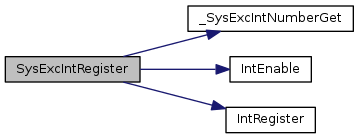|
EE445M RTOS
Taken at the University of Texas Spring 2015
|
|
EE445M RTOS
Taken at the University of Texas Spring 2015
|
Functions | |
| static uint32_t | _SysExcIntNumberGet (void) |
| void | SysExcIntRegister (void(*pfnHandler)(void)) |
| void | SysExcIntUnregister (void) |
| void | SysExcIntEnable (uint32_t ui32IntFlags) |
| void | SysExcIntDisable (uint32_t ui32IntFlags) |
| uint32_t | SysExcIntStatus (bool bMasked) |
| void | SysExcIntClear (uint32_t ui32IntFlags) |
|
static |
Returns the interrupt number for a system exception.
This function returns the interrupt number for a system exception.
Definition at line 66 of file sysexc.c.
References CLASS_IS_TM4C123, CLASS_IS_TM4C129, INT_SYSEXC_TM4C123, and INT_SYSEXC_TM4C129.
Referenced by SysExcIntRegister(), and SysExcIntUnregister().

| void SysExcIntClear | ( | uint32_t | ui32IntFlags | ) |
Clears system exception interrupt sources.
| ui32IntFlags | is a bit mask of the interrupt sources to be cleared. |
This function clears the specified system exception interrupt sources, so that they no longer assert. This function must be called in the interrupt handler to keep the interrupt from being recognized again immediately upon exit.
The ui32IntFlags parameter is the logical OR of any of the following:
Definition at line 298 of file sysexc.c.
References HWREG, and SYSEXC_IC.
| void SysExcIntDisable | ( | uint32_t | ui32IntFlags | ) |
Disables individual system exception interrupt sources.
| ui32IntFlags | is the bit mask of the interrupt sources to be disabled. |
This function disables the indicated system exception interrupt sources. Only sources that are enabled can be reflected to the processor interrupt; disabled sources have no effect on the processor.
The ui32IntFlags parameter is the logical OR of any of the following:
Definition at line 223 of file sysexc.c.
References HWREG, and SYSEXC_IM.
| void SysExcIntEnable | ( | uint32_t | ui32IntFlags | ) |
Enables individual system exception interrupt sources.
| ui32IntFlags | is the bit mask of the interrupt sources to be enabled. |
This function enables the indicated system exception interrupt sources. Only the sources that are enabled can be reflected to the processor interrupt; disabled sources have no effect on the processor.
The ui32IntFlags parameter is the logical OR of any of the following:
Definition at line 191 of file sysexc.c.
References HWREG, and SYSEXC_IM.
| void SysExcIntRegister | ( | void(*)(void) | pfnHandler | ) |
Registers an interrupt handler for the system exception interrupt.
| pfnHandler | is a pointer to the function to be called when the system exception interrupt occurs. |
This function places the address of the system exception interrupt handler into the interrupt vector table in SRAM. This function also enables the global interrupt in the interrupt controller; specific system exception interrupts must be enabled via SysExcIntEnable(). It is the interrupt handler's responsibility to clear the interrupt source.
Definition at line 108 of file sysexc.c.
References _SysExcIntNumberGet(), ASSERT, IntEnable(), and IntRegister().

| uint32_t SysExcIntStatus | ( | bool | bMasked | ) |
Gets the current system exception interrupt status.
| bMasked | is false if the raw interrupt status is required and true if the masked interrupt status is required. |
This function returns the system exception interrupt status. Either the raw interrupt status or the status of interrupts that are allowed to reflect to the processor can be returned.
Definition at line 249 of file sysexc.c.
References HWREG, SYSEXC_MIS, and SYSEXC_RIS.
| void SysExcIntUnregister | ( | void | ) |
Unregisters the system exception interrupt handler.
This function removes the system exception interrupt handler from the vector table in SRAM. This function also masks off the system exception interrupt in the interrupt controller so that the interrupt handler is no longer called.
Definition at line 146 of file sysexc.c.
References _SysExcIntNumberGet(), ASSERT, IntDisable(), and IntUnregister().
